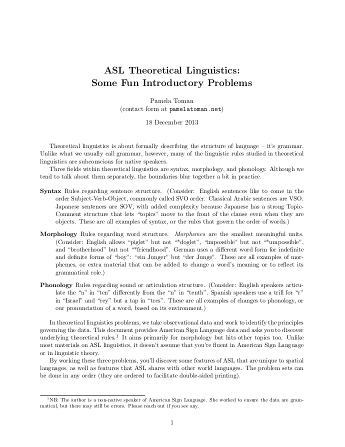One of my favorite parts of studying linguistics was being presented with data and being asked to find the system within it. Language data, with linguistic theory’s insistence that everything must make sense, make the most excellent data and logic puzzles.

As part of preparing for a spatial grammar-heavy meeting of the Montgomery Blair High School Linguistics Club, I developed three American Sign Language morphology problems. These problems illustrate interesting properties of American Sign Language that spoken languages do not have (non-manual markers, spatial agreement, and a rich temporal inflection system based in manual phonology).
Try your hand at doing the problems if you’re interested in any of the following:
- What it means to do theoretical linguistics (or the sort of logic skills that linguists develop)
- Unique properties of spatial languages
- Basic American Sign Language linguistics
- Similarities between American Sign Language and other world languages
Unlike most materials on ASL linguistics, the problems don’t assume that readers are fluent in American Sign Language or in linguistic theory — I developed these problems because I couldn’t find any resources aimed at an intelligent lay non-Deaf audience. The problems deliberately walk users through the steps to answer a question, whereas most theoretical linguistics problem sets jump straight to the questions at hand and assume existing familiarity with linguistic features not observed in English.
Once the club and I meet, I’ll post the answer sheet as well.